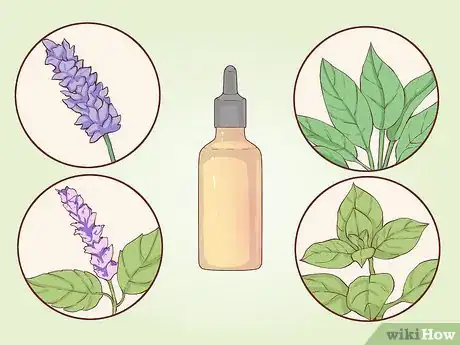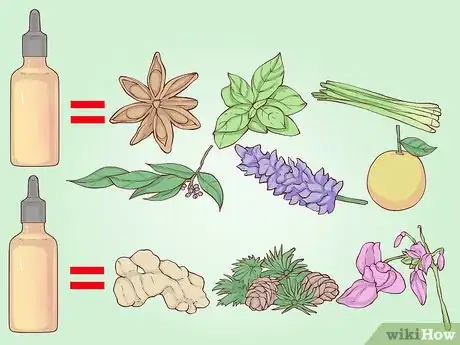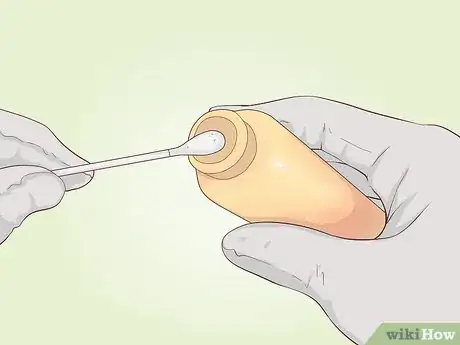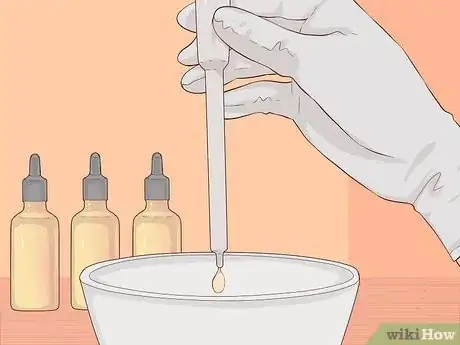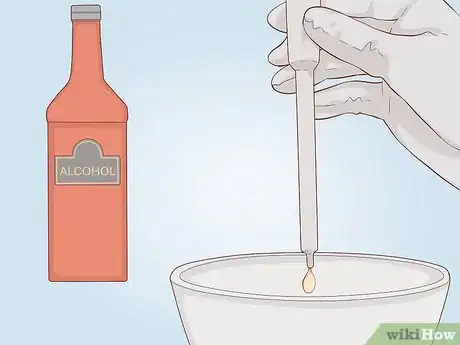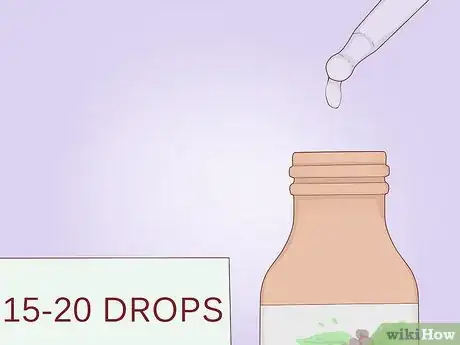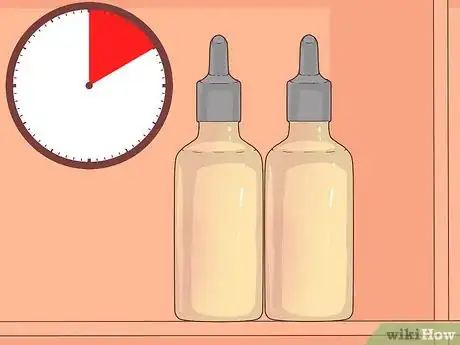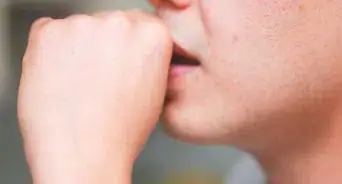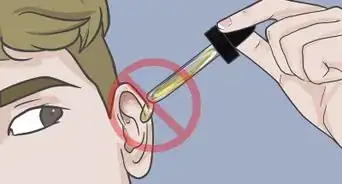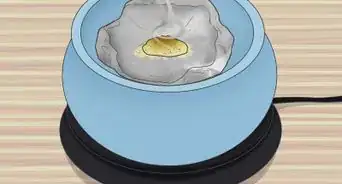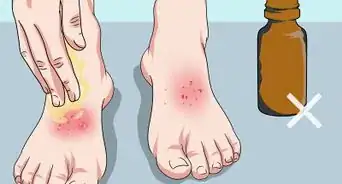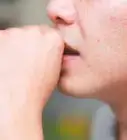This article was co-authored by Renee Hughes. Renee Hughes is a Certified Professional Aromatherapist and the CEO of The Aromaspecialists. With more than seven years of experience, she specializes in teaching others how to use aromatherapy and become certified aromatherapists. Renee received her training from The New Eden School of Natural Health and Herbal Studies. She is also a Level 2 National Association for Holistic Aromatherapy (NAHA) Certified Professional Aromatherapist and a NAHA Approved School Educator.
There are 15 references cited in this article, which can be found at the bottom of the page.
wikiHow marks an article as reader-approved once it receives enough positive feedback. In this case, 100% of readers who voted found the article helpful, earning it our reader-approved status.
This article has been viewed 110,395 times.
Essential oils can be mixed or used separately to scent skin scrubs, body butters, perfumes, and many other substances. Mixing these oils can be a fun activity as you get to try different scents and mixtures. To begin, you should combine your essential oils to create a pleasing and therapeutic scent. Essential oils must then be diluted with a carrier oil, dispersing agent, or alcohol for use on the skin. After you mix these together, you should safely store your oil, especially if you’re planning on aging the blend.
Steps
Formulating a Blend
-
1Determine what type of scent you want. Different types of scents are often used to alleviate different issues. Think about what type of scent you want. There are general categories of essential oil scent, and oils in any one category tend to mix well with their own kind. That said, you can mix scents from different categories. Try experimenting with different types of scents.[1] [2]
- Floral: Lavender, neroli, jasmine, ylang ylang, rose
- Earthy: Oakmoss, patchouli, pine, cedar
- Herbal: Marjoram, rosemary, basil, thyme
- Minty: Peppermint, spearmint, sage
- Spicy: Nutmeg, clove, cinnamon, black pepper
- Citrus: Orange, lemon, lime, bergamot
- It's always best to consult with a licensed aromatherapist when working with essential oils. They can guide you through the best practices for aromatherapy and warn you of any medical risks.[3]
-
2Choose top, middle, and base notes. The note of an oil refers to the length of time that it takes to evaporate. Top notes evaporate the quickest while base notes linger for a long time. If you want your oils to hold their aroma for a certain time, choose a good base note that pairs well with top and middle notes.
- Top notes evaporate within one or two hours. They include anise, basil, citronella, eucalyptus, lavender, spearmint, orange, and lemongrass.
- Middle notes evaporate within two to four hours. They include fennel, nutmeg, tea tree, jasmine, and chamomile.
- Base notes last for up to a few days. They include balsam, cedarwood, ginger, patchouli, and oakmoss.[4]
Advertisement -
3Test your blend. Dip one cotton swab into each bottle of oil. You should use one swab per bottle. Hold these about a foot away from your nose, and swirl them in circles in the air.[5] This will give you a sense of what the scent combination will smell like. If you do not like it, try removing one of the cotton swabs, and try again.[6] This will help you find a good combination of aromas for your blend.
- You can also use cotton balls or fragrance testing strips to try out your scents.
-
4Mix the oils. Once you have determined your essential oil blend, you can start adding them together. Using a pipette or dropper, drop the measured amounts of your top, middle, and base notes into a clean mixing bowl or into a glass vial. Drop the correct amount of drops as stated per the recipe you are using. If you are unsure how much to use, you can follow a few different guidelines:
- The 30-50-20 rule: your mixture is 30% of your top note, 50% of your middle note, and 20% of your base note.[7]
- The 1-2-3 Rule: For every one drop of your base note, you have two drops of your middle note and three drops of your top note.[8]
- You should mix your essential oils together first before adding any carriers or diluting agents.[9]
Diluting Your Oils
-
1Find a carrier oil if you want to apply it to the skin. If you are applying essential oils to the skin, you will need to dilute them with a carrier oil first.[10] Essential oils are highly concentrated, and by applying them directly to your skin without a carrier oil, you risk permanent damage to your skin.[11] Carrier oils are typically vegetable oils. Good carrier oils include:
- Almond Oil[12]
- Rosehip Oil
- Avocado Oil
- Sesame Oil
- Jojoba Oil
- Hemp Seed Oil
- Olive Oil[13]
- Coconut Oil
- Sunflower Oil
- Grape Seed Oil[14]
- There are very few times when you will not need a carrier oil when working with essential oils. In some cases, you can get a really significant burn if you apply undiluted essential oils to your skin.[15]
-
2Add a dispersing agent if you want to use it in the bath. If you are not planning to rub it directly on the skin but do want to use it in the bath, you should use a dispersing agent. A dispersing agent will help the oil spread through the bath safely. While some vegetable oils can be used as a dispersing agent, others, like coconut oil, are too thick for use in the bath. Try using an oil with a lighter, more liquid viscosity.[16] Some good agents include:
- Honey
- Milk
- Jojoba Oil
- Sweet Almond Oil
-
3Mix with alcohol for a perfume. Perfumes are used in smaller applications. While you can use jojoba oil for a perfume, alcohol is typically the preferred diluting agent. Use between ten and fifteen drops of essential oil blend per half ounce (15 ml) of alcohol or jojoba oil.[17]
Completing Your Blend
-
1Determine your proportion of ingredients. Once you have mixed your essential oils, you can add them to a carrier oil or dispersing agent, depending on your use of the oil. How much of each ingredient you mix together depends on how you are planning on using your essential oil.
- For massages, use between fifteen and twenty drops of essential oil blend per ounce of carrier oil.
- For lotions or skin oils, use between three and fifteen drops per ounce of carrier oil.
- For use on children, use three to six drops per ounce of carrier oil.
- For baths, use between two and twelve drops of oil per ounce of dispersing agent.[18]
- If you are using essential oils for smelling or inhaling only, you do not need a carrier oil.
-
2Combine the essential oil blend with the diluting agent. You can combine your ingredients in a bowl or in a bottle. If you are mixing your oils in a bowl, you should mix the oil by stirring the oil with a spoon. Wooden stir sticks may also help. If you are mixing your oils in a bottle, you can gently swirl the bottle in your hand to mix the oils.[19]
-
3Store in a bottle. Glass vials, bottles, and sprayers are a good way to store your essential oil blends. Amber bottles with a volume of two to four millimeters are often recommended to store essential oils.[20] Carefully pour the blended oil inside the container; you may use a funnel if it helps. Keep the blend in a cool, dark area.
- Carrier oils may expire more quickly than essential oils. Blends with rosehip, sesame, or sweet almond oil can be stored for 6-12 months. Jojoba oil and coconut oil are very stable and may last indefinitely.
- You may also store the blended oil in the refrigerator. The exception to this is any blend containing avocado oil, which should not be stored in the fridge.
- Do not use if your oils smell bitter or rancid.[21]
- Do not store the oils in direct sunlight or near a stove.[22]
-
4Wait a few days. The scent of an essential oil blend can change as the oils settle.[23] Let the essential oil sit for three or four days before you try smelling it again. Note if the scent has changed significantly. This will tell you how a blend ages. By aging some of your blends, you might find more satisfying scents.
Expert Q&A
-
QuestionHow do you blend essential oils for a diffuser?
 Renee HughesRenee Hughes is a Certified Professional Aromatherapist and the CEO of The Aromaspecialists. With more than seven years of experience, she specializes in teaching others how to use aromatherapy and become certified aromatherapists. Renee received her training from The New Eden School of Natural Health and Herbal Studies. She is also a Level 2 National Association for Holistic Aromatherapy (NAHA) Certified Professional Aromatherapist and a NAHA Approved School Educator.
Renee HughesRenee Hughes is a Certified Professional Aromatherapist and the CEO of The Aromaspecialists. With more than seven years of experience, she specializes in teaching others how to use aromatherapy and become certified aromatherapists. Renee received her training from The New Eden School of Natural Health and Herbal Studies. She is also a Level 2 National Association for Holistic Aromatherapy (NAHA) Certified Professional Aromatherapist and a NAHA Approved School Educator.
Certified Professional Aromatherapist Stick with thinner oils, since oils like vetiver or patchouli are often too thick for a diffuser. Once you're finished, be sure to clean your diffuser out before using it again.
Stick with thinner oils, since oils like vetiver or patchouli are often too thick for a diffuser. Once you're finished, be sure to clean your diffuser out before using it again. -
QuestionHow many drops of essential oil do you put in diffuser?
 Renee HughesRenee Hughes is a Certified Professional Aromatherapist and the CEO of The Aromaspecialists. With more than seven years of experience, she specializes in teaching others how to use aromatherapy and become certified aromatherapists. Renee received her training from The New Eden School of Natural Health and Herbal Studies. She is also a Level 2 National Association for Holistic Aromatherapy (NAHA) Certified Professional Aromatherapist and a NAHA Approved School Educator.
Renee HughesRenee Hughes is a Certified Professional Aromatherapist and the CEO of The Aromaspecialists. With more than seven years of experience, she specializes in teaching others how to use aromatherapy and become certified aromatherapists. Renee received her training from The New Eden School of Natural Health and Herbal Studies. She is also a Level 2 National Association for Holistic Aromatherapy (NAHA) Certified Professional Aromatherapist and a NAHA Approved School Educator.
Certified Professional Aromatherapist Add between 3 and 8 drops of essential oil to your diffuser—don't use any more than that, or else it could be overkill.
Add between 3 and 8 drops of essential oil to your diffuser—don't use any more than that, or else it could be overkill. -
QuestionWhat are the benefits of aromatherapy?
 Ritu Thakur, MARitu Thakur is a healthcare consultant in Delhi, India, with over 10 years of experience in Ayurveda, Naturopathy, Yoga, and Holistic Care. She received her Bachelor Degree in Medicine (BAMS) in 2009 from BU University, Bhopal followed by her Master's in Health Care in 2011 from Apollo Institute of Health Care Management, Hyderabad.
Ritu Thakur, MARitu Thakur is a healthcare consultant in Delhi, India, with over 10 years of experience in Ayurveda, Naturopathy, Yoga, and Holistic Care. She received her Bachelor Degree in Medicine (BAMS) in 2009 from BU University, Bhopal followed by her Master's in Health Care in 2011 from Apollo Institute of Health Care Management, Hyderabad.
Natural Health Care Professional Aromatherapy is a natural, holistic approach which uses natural plant extracts to treat and relieve the mind and body. There many benefits of aromatherapy depending on the oils you're using. There are aromas that can make it easier to sleep, reduce pain, or even soothe sore muscles!
Aromatherapy is a natural, holistic approach which uses natural plant extracts to treat and relieve the mind and body. There many benefits of aromatherapy depending on the oils you're using. There are aromas that can make it easier to sleep, reduce pain, or even soothe sore muscles!
Warnings
- Undiluted essential oils can cause permanent damage in some cases. Do not let them touch broken or cut skin.⧼thumbs_response⧽
- Never take essential oils by mouth.⧼thumbs_response⧽
- Be careful when touching some types of essential oils. Their acidity can eat through your skin and burn you.⧼thumbs_response⧽
References
- ↑ http://www.aromaweb.com/articles/aromaticblending.asp
- ↑ https://achs.edu/blog/2018/03/09/blending-101-the-art-of-pairing/
- ↑ Renee Hughes. Certified Professional Aromatherapist. Expert Interview. 14 April 2022.
- ↑ http://www.aromaweb.com/articles/aromaticblending.asp
- ↑ https://achs.edu/blog/2018/03/09/blending-101-the-art-of-pairing/
- ↑ https://www.youtube.com/watch?v=z2sYnbkPtgo&feature=youtu.be&t=180
- ↑ https://eotq.org/let-the-magic-happen-blending-essential-oils/
- ↑ https://books.google.com/books?id=A4WySEH3GWEC&lpg=PP1&dq=how%20to%20blend%20essential%20oils&pg=PA24-IA1#v=onepage&q&f=false
- ↑ http://www.aromaweb.com/articles/therapeuticblending.asp
- ↑ Renee Hughes. Certified Professional Aromatherapist. Expert Interview. 14 April 2022.
- ↑ http://www.aromaweb.com/articles/dilutingessentialoils.asp
- ↑ Renee Hughes. Certified Professional Aromatherapist. Expert Interview. 14 April 2022.
- ↑ Renee Hughes. Certified Professional Aromatherapist. Expert Interview. 14 April 2022.
- ↑ http://www.aromaweb.com/articles/whatcarr.asp
- ↑ Renee Hughes. Certified Professional Aromatherapist. Expert Interview. 14 April 2022.
- ↑ https://naha.org/explore-aromatherapy/about-aromatherapy/methods-of-application/
- ↑ https://books.google.com/books?id=KTaCJg1nVJ0C&lpg=PA123&dq=how%20to%20blend%20essential%20oils&pg=PA68#v=onepage&q=alcohol&f=false
- ↑ https://naha.org/explore-aromatherapy/about-aromatherapy/methods-of-application/
- ↑ https://books.google.com/books?id=A4WySEH3GWEC&lpg=PP1&dq=how%20to%20blend%20essential%20oils&pg=PA24-IA1#v=onepage&q&f=false
- ↑ http://www.aromaweb.com/articles/aromaticblending.asp
- ↑ http://www.aromaweb.com/articles/whatcarr.asp
- ↑ https://www.hopkinsallchildrens.org/ACH-News/General-News/Are-Essential-Oils-Safe-for-Children
- ↑ http://www.aromaweb.com/articles/aromaticblending.asp
About This Article
To blend essential oils, try mixing different combinations of lavender, neroli, jasmine, ylang-ylang, and rose oil to get strong floral scents. If you'd prefer an earthy smell, experiment with oakmoss, patchouli, pine, and cedar oil. For an herbal scent, try mixing marjoram, rosemary, basil, and thyme oil. To make a minty smell, play around with peppermint, spearmint, and sage. Or, if you're looking for a citrus scent, try blending orange, lemon, lime, and bergamot oil. To learn how to mix essential oils together to make a blend, scroll down!
